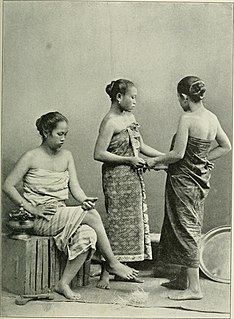
A hairstyle, hairdo, or haircut refers to the styling of hair, usually on the human scalp. Sometimes, this could also mean an editing of facial or body hair. The fashioning of hair can be considered an aspect of personal grooming, fashion, and cosmetics, although practical, cultural, and popular considerations also influence some hairstyles.

Victorian fashion consists of the various fashions and trends in British culture that emerged and developed in the United Kingdom and the British Empire throughout the Victorian era, roughly from the 1830s through the 1890s. The period saw many changes in fashion, including changes in styles, fashion technology and the methods of distribution. Various movement in architecture, literature, and the decorative and visual arts as well as a changing perception of the traditional gender roles also influenced fashion.

A sarong or sarung ; is a large tube or length of fabric, often wrapped around the waist, worn in Southeast Asia, Southern Asia, Western Asia, Northern Africa, East Africa, West Africa and on many Pacific islands. The fabric often has woven plaid or checkered patterns, or may be brightly colored by means of batik or ikat dyeing. Many modern sarongs have printed designs, often depicting animals or plants. Different types of sarongs are worn in different places in the world, notably, the lungi in the Indian subcontinent and the izaar in the Arabian Peninsula.

The hanbok or Chosŏn-ot is the traditional Korean clothes. The term "Hanbok" literally means "Korean clothing". It was established as a part of the unique living culture of Korea, influenced by the geographical and climatic nature of the Korea, and handed down throughout the years to present times.

Indigenous peoples of the Northwest Plateau, also referred to by the phrase Indigenous peoples of the Plateau, and historically called the Plateau Indians are indigenous peoples of the Interior of British Columbia, Canada, and the non-coastal regions of the Northwestern United States.

Culottes are an item of clothing worn on the lower half of the body. The term can refer to split skirts, historical men's breeches, or women's under-pants; this is an example of fashion-industry words taken from designs across history, languages and cultures, then being used to describe different garments, often creating confusion among historians and readers. The French word culotte is panties, pants, knickers, trousers, shorts, or (historically) breeches; derived from the French word culot, meaning the lower half of a thing, the lower garment in this case.
Karadiya Rajput is an Indian Hindu caste of the Rajput community.

The preservation of fabric fibers and leathers allows for insights into the attire of ancient societies. The clothing used in the ancient world reflects the technologies that these peoples mastered. In many cultures, clothing indicated the social status of various members of society.

Mekhela Sador is the indigenous traditional Assamese dress worn by Assamese women.

Khmer traditional clothing refers to the traditional styles of dress worn by the Khmer people from ancient times to the present.
Romanian dress refers to the traditional clothing worn by Romanians, who live primarily in Romania and Moldova, with smaller communities in Ukraine and Serbia. Today, the vast majority of Romanians wear modern style dress on most occasions, and the garments described here largely fell out of use during the 20th century. However, they can still be seen in more remote areas, on special occasions, and at ethnographic and folk events. Each historical region has its own specific variety of costume.

Clothing in ancient Greece primarily consisted of the chiton, peplos, himation, and chlamys. Ancient Greek civilians typically wore two pieces of clothing draped about the body: an undergarment and a cloak.

Chima is a type of skirt worn together with jeogori, or a short jacket in hanbok, Korean traditional clothing. It is also referred to as sang (裳) or gun (裙) in hanja in the Korean language.
The Medieval period in England is usually classified as the time between the fall of the Roman Empire to the beginning of the Renaissance, roughly the years AD 410–1485. For various peoples living in England, the Anglo-Saxons, Anglo-Danes, Normans and Britons, clothing in the medieval era differed widely for men and women as well as for different classes in the social hierarchy. The general styles of Early medieval European dress were shared in England. In the later part of the period, men's clothing changed much more rapidly than women's styles. Clothes were very expensive and both the men and women of lower social classes continued to wear them until the garments were in such disrepair that they needed to be replaced entirely. Sumptuary laws also divided social classes by regulating the colors and styles these various ranks were permitted to wear. In the early Middle Ages, clothing was typically simple and, particularly in the case of lower-class peoples, served only basic utilitarian functions such as modesty and protection from the elements. As time went on the advent of more advanced textile techniques and increased international relations, clothing gradually got more and more intricate and elegant, even with those under the wealthy classes, up into the renaissance.

Ancient Egyptian clothes refers to clothing worn in ancient Egypt from the end of the Neolithic period to the collapse of the Ptolemaic Kingdom with the death of Cleopatra in 30 BC. Egyptian clothing was filled with a variety of colors. Adorned with precious gems and jewels, the fashions of the ancient Egyptians were made for not only beauty but also comfort. Egyptian fashion was created to keep cool while in the hot desert.

The Hajong are a tribal group native to the Indian subcontinent, notably in the northeast Indian states and Bangladesh. The majority of the Hajongs are settled in India. Hajongs are predominantly rice farmers. They are said to have brought wet-field cultivation to Garo Hills, where the Garo people used slash and burn method of agriculture. Hajong have the status of a Scheduled Tribe in India.

Fashion and clothing in the Philippines refers to the way the people of Filipino society dress up in instances such as while they are at home, at work, travelling and when attending special occasions.

The Chutia people are a indigenous people belonging to the Bodo-Kachari family and are associated with the historic Chutia kingdom. The Chutia kingdom's territory encompassed the present Lakhimpur, Dhemaji, Dibrugarh and Tinsukia districts of Assam; but after the kingdom was absorbed into the Ahom kingdom in 1523-24 the Chutiya population was widely dispersed in the entire Upper Assam. They constitute one of the core groups that form the Assamese people.

Traditional Hajong marriage is a ceremonial ritual that involves a marriage established by pre-arrangement between families. Within Hajong culture, romantic love and widow re-marriage was allowed, and monogamy was the norm for the Hajong people.

An Argon is a traditional shawl-like garment worn by Hajong women in the Indian subcontinent, in modern-day India and Bangladesh.






















